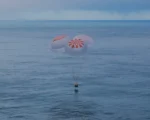SpaceX successfully launched 131 satellites into orbit during its Transporter 12 mission on January 14, 2025. The launch took place from Vandenberg Space Force Base in California, with the Falcon 9 rocket lifting off at 2:09 p.m. EST. This mission continues to build on SpaceX’s rideshare program, which provides an efficient way to send multiple payloads into space for various customers with a single rocket. The Transporter 12 mission not only highlights SpaceX’s technical capabilities but also its commitment to making space access more affordable and accessible for a wide range of clients, including both commercial and government entities.
One of the notable aspects of this mission was the successful landing of the Falcon 9’s first-stage booster, which touched down at Vandenberg’s Landing Zone 4 approximately 7.5 minutes after launch. This achievement further underscores SpaceX’s progress in reusable rocket technology, which significantly reduces the cost of space launches. Transporter 12 is the 12th mission in SpaceX’s Transporter series, designed to carry multiple payloads, with this flight including satellites from a variety of companies. Notably, 37 of the satellites were from Planet Labs, a company based in San Francisco, specializing in Earth observation.
Among the Planet Labs payloads were 36 SuperDove cubesats and a single Pelican-2 satellite. The SuperDove satellites are equipped for high-resolution imaging of Earth’s surface, while the Pelican-2 satellite boasts advanced AI-powered solutions designed to analyze data in near real-time. This mission not only helped deploy satellites aimed at providing critical Earth observation data but also demonstrated how space technology is evolving with the integration of artificial intelligence to enhance data collection and processing capabilities.
With the successful completion of Transporter 12, SpaceX has now launched over 1,100 satellites across 13 rideshare missions, cementing its position as a leader in small satellite deployment. The satellites deployed during the mission were sent into low Earth orbit over a 90-minute period, beginning 54 minutes after launch. These consistent and efficient rideshare missions, which have served over 130 clients, continue to drive the expansion of the commercial space industry, providing key infrastructure for a wide range of industries, from telecommunications to Earth observation.

















